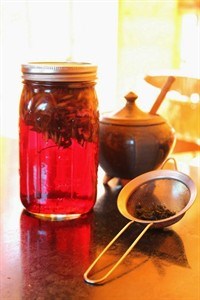
This photo provided by courtesy of Skyhorse Publishing shows oat tops, rose hips, hibiscus and red raspberry leaf steeping in the sunlight. As craft tea seeps into the mainstream, tea gardens are becoming a popular way for brew lovers to bypass the store and enjoy tea’s benefits without additives or preservatives. (AP Photo/Skyhorse Publishing, Abigail Gehring)
January 22, 2014 - 6:22 AM
When temperatures fall, there's nothing better than a piping hot cup of tea.
And as craft and organic tea seeps into the mainstream, tea gardens are becoming a popular way for brew lovers to bypass the store and enjoy the benefits of herbal tea without additives or preservatives.
"It just tastes and smells better," says chef Kimmy Tang, who snips mint, lavender and lemongrass from her garden for herbal teas at her 9021PHO restaurants in Los Angeles.
"I also know that it's 100 per cent organic. I don't use any chemicals to help them grow, and I can taste the difference."
It may sound daunting, but British gardener and author Cassie Liversidge says many tea garden staples may already be at your fingertips.
"Honeysuckle, mint, rosemary. They're all quite common plants, but can be turned into tea," says Liversidge, author of the forthcoming book "Homegrown Tea: An Illustrated Guide to Planting, Harvesting and Blending Teas and Tisanes" (St. Martin's Griffin, March 2014).
She and other tea gardeners offer the following tips to get your feet wet:
GROWING
First and foremost, no sprawling English estate is required here.
Tea gardens come in many forms, and don't even need to be in the ground. Tang grows her herbs in a vertical garden hanging on a wall behind her restaurants, while other city dwellers cramped for space use pots and other containers.
All you need is dirt, water and some seeds.
"A great way to get started is to buy a plastic indoor sun garden at Lowe's or Home Depot, along with the seeds and pieces of dirt that expand with water," says McCollonough Ceili, a 26-year-old author who grows lavender, sage, mint and other herbs outside her kitchen window in Tennessee.
Liversidge recommends easy-to-grow plants like mint, lavender or chamomile for beginners.
If you've already got those growing, take a stab at other popular tea ingredients like coriander, lemon balm, rose hips, hibiscus and jasmine.
Keep the plants in an area that gets at least six hours of sunlight each day, rotate them often and monitor moisture per directions on the seed packet.
HARVESTING/DRYING
Each plant is unique when it comes to harvesting.
The flower tops are the most medicinal part of the rosemary plant, for example, so be sure to clip those off along with the leaves for tea, Liversidge says.
Fennel is valued for its seeds, and those must be shaken out from the flowers once they turn brown. Snip flowers like chamomile at the base of their stems, not the top, so you can use the stems, leaves and petals in your brew, according to Liversidge.
Many herbs can be used fresh, but drying them is a good way to keep your tea cupboard stocked through the winter.
Tie them up and hang them in bundles to dry, or spread them out on a flat surface in the sun. A dehydrator or an oven at a temperature of 212 degrees Fahrenheit or lower can also be used.
"With my lemongrass, I cut it and freeze it to keep the nutrients locked in," says Tang.
No matter the method, be sure to store your tea ingredients in airtight containers.
BREWING
There are a few ways to brew your homemade tea, depending on the ingredients and personal preference.
Hershey, Pa.-based writer and photographer Amy Renea prefers to "chop off big hunks" of fresh mint, lemon balm, chamomile and sometimes stevia from her tea garden and put them right in the tea kettle.
Once it's reached boiling, pull the kettle off the heat and let it sit for a few minutes before pouring into your favourite tea cup.
"I strain the tea through a small tea mesh strainer, but any strainer will do," Renea says.
Liversidge prefers filling empty tea bags with homemade ingredients — "then you're not tempted to put too much water with it" — and letting them steep about three minutes before enjoying.
For the freshest tea possible, she advises pouring fresh water into your tea kettle every time. It has more oxygen, which will bring out the tea's flavour.
Here is a recipe for a Vitamin C "power blend" tea from the forthcoming "Medicinal Gardening Handbook" (Skyhorse Publishing, May 2014) by Vermont gardeners and neighbours Alyssa Holmes and Dede Cummings:
1 part rose hips
1 part hibiscus
2 parts lemon balm
1 part dandelion blossoms
1/2 part rosebuds
Pour into a quart jar and fill with boiling water. Cover and let steep for at least 15 minutes or up to eight hours. Strain before drinking.
___
Online:
Cassie Liversidge: http://cassieliversidge.com
Amy Renea: www.anestforallseasons.com
The Medicinal Gardening Handbook: http://medicinalgardening.wordpress.com
9021PHO: www.90210PHO.com
News from © The Associated Press, 2014